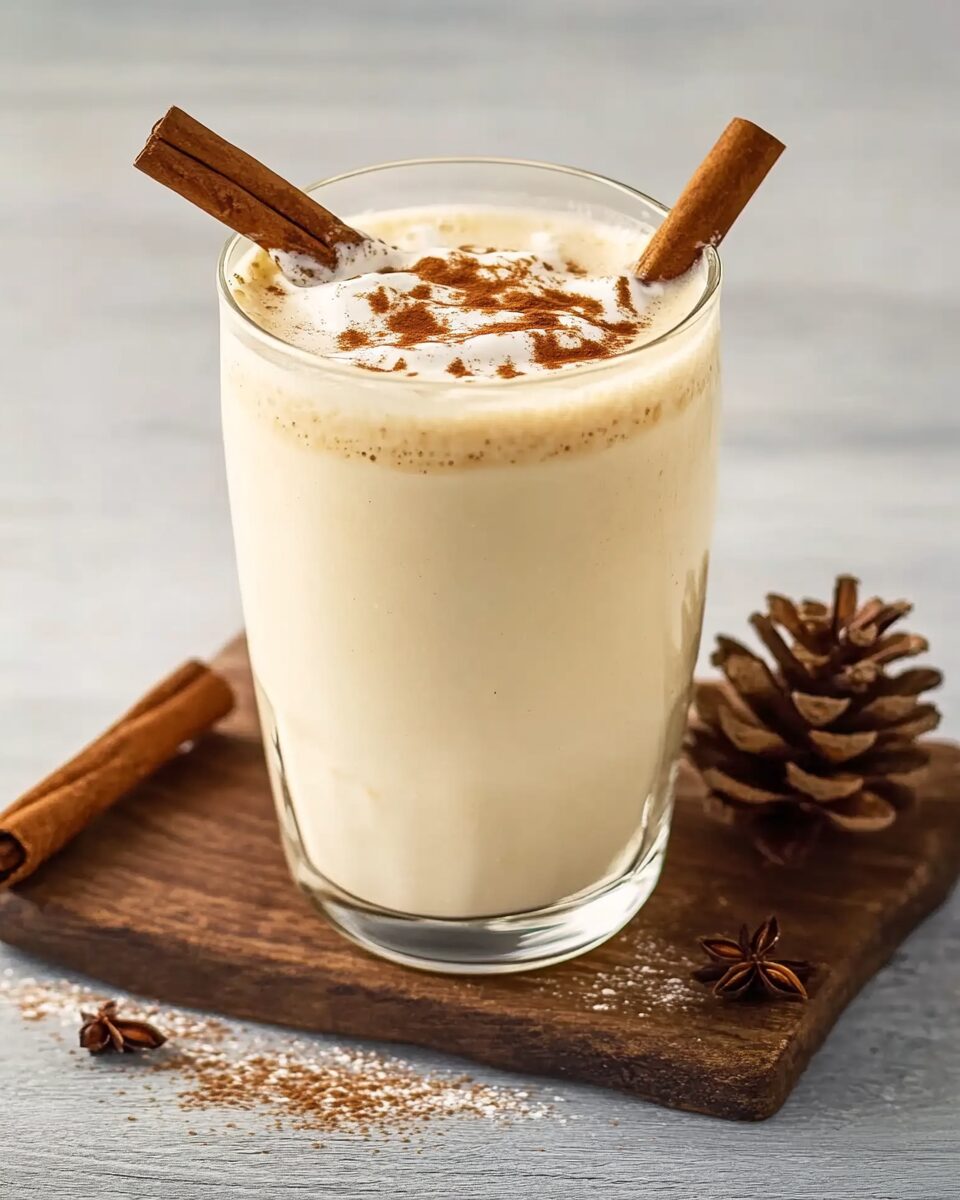This homemade eggnog is an invitation to warm up with holiday comfort in a glass. Made with simple ingredients like milk, cream, and a hint of rum, it’s rich, creamy, and spiced with classic holiday flavors of cinnamon, nutmeg, and vanilla. It’s a perfect addition to any holiday gathering, whether served as-is or with a touch of rum for an extra festive kick.
The beauty of this recipe is in its simplicity and taste. It’s easy to prepare yet delivers a luxurious texture that can’t be matched by store-bought versions. Serve it chilled or warm, depending on your preference, and enjoy the velvety sip that brings out the magic of the season. Perfect for cozy nights by the fire or toasting with loved ones, this eggnog is holiday cheer in a cup.
Full Recipe:
-
- 2 cups milk
- 1/2 teaspoon ground cinnamon
- 1/8 teaspoon ground cloves
- 1/2 teaspoon vanilla extract (divided)
- 6 egg yolks
- 3/4 cup white sugar
- 2 cups light cream
- 1/2 cup light rum (optional)
- 1 teaspoon ground nutmeg
- Directions:
- In a medium saucepan, combine milk, cinnamon, cloves, and 1/4 teaspoon of vanilla extract. Heat until the mixture just begins to boil, then remove from heat.
- In a large bowl, whisk the egg yolks until smooth. Gradually add sugar, whisking until smooth and creamy.
- Slowly add the hot milk mixture into the egg mixture, whisking constantly.
- Return the mixture to the saucepan and cook over medium heat, stirring constantly until it thickens (around 3-5 minutes). Remove from heat and strain out the cloves.
- Let cool slightly, then stir in the cream, remaining vanilla extract, rum (if using), and nutmeg.
- Cover and refrigerate overnight for the best flavor.
- Prep Time: 15 minutes | Cooking Time: 10 minutes | Total Time: 25 minutes
- Kcal: 240 kcal | Servings: 8 servings
The Rich Tradition of Eggnog: A Classic Holiday Drink
Eggnog, with its creamy texture and spiced sweetness, has been a beloved holiday drink for centuries. Originating as a drink of the elite, it has evolved into a Christmas and New Year staple enjoyed by people across the globe. Whether served with a splash of alcohol or as a non-alcoholic treat, this drink offers a taste of nostalgia, bringing warmth and festivity to the holiday season. This article dives into the history, cultural significance, variations, and the many reasons to consider homemade eggnog as the perfect holiday indulgence.
A Brief History of Eggnog
The origins of eggnog date back to medieval England. Back then, a warm ale-based drink called “posset” was often used as a remedy for colds. The recipe evolved with the addition of eggs, milk, and spices. By the 17th century, posset had morphed into a drink associated with celebration and prosperity, especially among the British aristocracy.
When eggnog made its way to the American colonies in the 18th century, rum became the spirit of choice due to its affordability and availability in the Caribbean trade routes. This blend of rich cream, eggs, sugar, spices, and rum became an instant favorite, particularly during the winter holidays. Even President George Washington was known to serve a highly alcoholic version of eggnog at his Christmas parties.
Why Eggnog Is the Perfect Festive Beverage
Eggnog has a unique ability to capture the spirit of the holidays, thanks to its rich flavors and creamy texture. The drink’s hallmark spices—nutmeg, cinnamon, and cloves—evoke a sense of warmth and coziness, especially during the cold winter months. Whether it’s served cold or warm, eggnog has a comforting quality that makes it perfect for gatherings. The drink can be easily customized with a variety of spirits, or enjoyed as a kid-friendly version by omitting the alcohol.
Eggnog is often associated with Christmas, but it can be enjoyed throughout the winter. Families gather around mugs of this delicious beverage, which has become a symbol of holiday cheer and shared moments. Some households even have specific eggnog recipes that are handed down through generations, creating a unique, family-specific take on this traditional drink.
Cultural Significance and Popularity
Eggnog has become a mainstay in American holiday culture, with many families looking forward to its seasonal appearance in stores. Commercial eggnog sales soar during the months of November and December, and nearly every grocery store in the U.S. carries some version of it. The drink’s association with the holiday season is so strong that, for many, it doesn’t feel like Christmas until eggnog is poured.
While eggnog is most popular in the United States, it has also spread to other parts of the world. In Puerto Rico, a coconut-flavored version called “coquito” is widely enjoyed. In Mexico, a similar drink known as “rompope” is made with a blend of eggs, sugar, and vanilla, often flavored with almonds. Each version reflects regional tastes and ingredients, showing how eggnog can be adapted across cultures while maintaining its core qualities.
Variations of Eggnog
Though traditional eggnog is made with milk, cream, eggs, sugar, and nutmeg, there are countless variations that can make this drink more accessible or exciting. Here are a few popular adaptations:
- Alcohol-Free Eggnog: For those who prefer a non-alcoholic version, simply omit the rum or any other spirit. This version is especially popular for family gatherings where both children and adults can enjoy the drink together.
- Vegan Eggnog: Dairy-free and egg-free versions of eggnog have become widely available, using ingredients like almond milk, coconut milk, and cashew cream as substitutes. Some vegan recipes use aquafaba, the liquid from canned chickpeas, to replicate the frothy texture that egg whites provide.
- Flavored Eggnog: While classic eggnog is flavored with nutmeg, cinnamon, and vanilla, adding other flavors can provide an exciting twist. Chocolate eggnog, coffee eggnog, and even peppermint-flavored eggnog are popular choices that add a new layer of complexity to the drink.
- Spirited Eggnog: Besides rum, other spirits like bourbon, brandy, or whiskey can add depth and warmth. Each spirit brings its own flavor profile; bourbon adds sweetness, brandy adds richness, and whiskey offers a robust kick.
- Low-Calorie Eggnog: By substituting some of the cream with milk or using a low-calorie sweetener, you can create a lighter version of eggnog that maintains the classic taste without as many calories.
How to Serve Eggnog
The presentation of eggnog can be as simple or as festive as you like. Serving eggnog in glass mugs or cups, topped with a sprinkle of nutmeg or a cinnamon stick, is a beautiful way to showcase this holiday drink. If you’re serving eggnog at a party, a large punch bowl with a ladle allows guests to help themselves and adds a festive touch. You can also garnish each glass with whipped cream or a sprinkle of grated chocolate for added decadence.
Some people enjoy eggnog warm, while others prefer it chilled. Warm eggnog has a cozy, comforting feel and is perfect for sipping by the fireplace, while chilled eggnog offers a refreshing contrast to rich holiday foods. No matter how you serve it, eggnog’s smooth texture and balanced sweetness make it a versatile addition to any holiday celebration.
Storage Tips for Homemade Eggnog
Proper storage is key to ensuring your eggnog stays fresh. Here are a few tips for keeping it in top condition:
- Refrigeration: Homemade eggnog should be kept in an airtight container in the refrigerator and consumed within three days. If your recipe includes alcohol, it may last slightly longer, as alcohol can help inhibit bacterial growth.
- Freezing Eggnog: Eggnog can be frozen for longer storage. If you choose to freeze it, leave some room at the top of the container, as the liquid will expand. When you’re ready to enjoy it, thaw the eggnog in the refrigerator overnight. Keep in mind that freezing may slightly alter the texture, so give it a good stir or blend before serving.
- Batch-Making: If you’re making eggnog for a large gathering, consider preparing it a day in advance. The flavors of eggnog tend to meld and improve after resting for a few hours, making it even more delicious.
Health Considerations
Eggnog is a rich, calorie-dense drink due to its ingredients, which include cream, eggs, and sugar. While it’s a delicious treat, it’s best enjoyed in moderation, especially for those watching their calorie or cholesterol intake.
For a lighter option, consider substituting whole milk for part of the cream or reducing the sugar. If you’re serving eggnog to a group with dietary restrictions, offering vegan or low-calorie options can be a considerate touch.
Another health consideration is the use of raw eggs, which some recipes call for. If you’re concerned about food safety, you can use pasteurized eggs or gently cook the eggnog base to ensure the eggs reach a safe temperature. This is particularly important for those serving eggnog to children, the elderly, or anyone with a compromised immune system.
Conclusion: Why Homemade Eggnog Is Worth the Effort
There’s a special satisfaction in making eggnog from scratch. Unlike store-bought versions, homemade eggnog allows you to control the ingredients and adjust the flavors to suit your taste. The process of whisking, simmering, and blending gives you a chance to slow down and enjoy the spirit of the season. The aromas of cinnamon, nutmeg, and vanilla that fill the kitchen are a delightful reminder of the holidays.
Homemade eggnog isn’t just a drink—it’s an experience. Whether you’re preparing it for a holiday party or a cozy night at home, each sip captures the warmth and joy of the season. From its historical roots to its status as a holiday staple, eggnog holds a timeless appeal that has been cherished for generations. With a glass of homemade eggnog, you’re not just celebrating the holidays; you’re carrying on a tradition that has brought people together for centuries.

